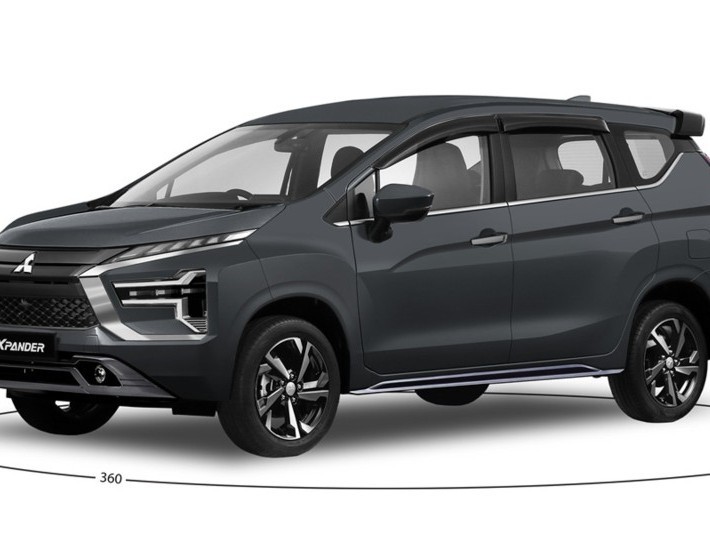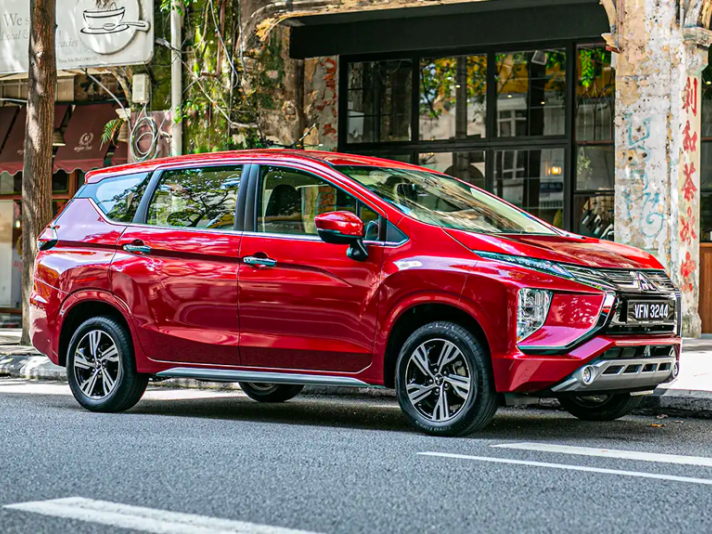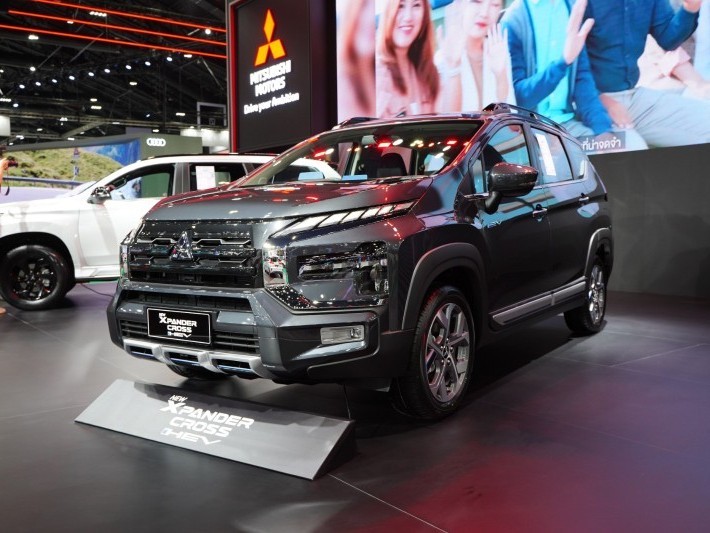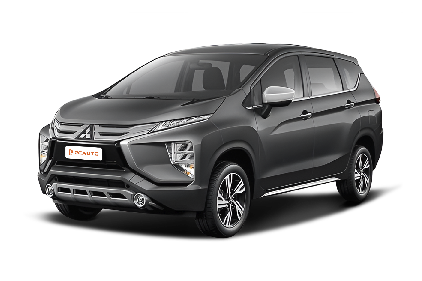Q
How to drive an automatic Mitsubishi Xpander?
Driving the Mitsubishi Xpander automatic is a breeze. First, make sure the vehicle is in P (Park). Press the brake pedal, start the engine, then shift from P to D (Drive). Let go of the brake and gently press the accelerator to pull away smoothly. The transmission shifts automatically while driving, so no manual input is needed. When hitting a red light or stopping temporarily, you can stay in D and keep the brake pressed, or shift to N (Neutral). For longer stops, it's best to shift back to P and engage the handbrake. When reversing, come to a complete stop first before shifting to R (Reverse). There's also a Sport mode (S) for when you need a bit more power. It's worth noting the Xpander uses a CVT gearbox, so avoiding sudden heavy acceleration will give you a smoother drive and better fuel economy. Additionally, regularly checking the transmission fluid and keeping up with maintenance are key to prolonging the gearbox's lifespan. With Malaysia's rainy and slippery roads, using the Low gear (L) appropriately can help improve control when climbing or descending slopes. Once you get the hang of these operations, you'll be轻松驾驭ing this family-friendly 7-seater MPV in no time.
Special Disclaimer: This content is published by users and does not represent the views or position of PCauto.
Related Q&A
Q
Is Xpander 2024 3 cylinder?
Based on the current information, the 2024 Mitsubishi Xpander available in the Malaysian market is equipped with a 1.5 - liter MIVEC four - cylinder naturally aspirated engine, not a three - cylinder configuration. This engine delivers 105 horsepower and 141 Nm of torque, paired with either a 5 - speed manual or a 4 - speed automatic transmission. It focuses on providing smoothness and fuel efficiency for the family car market.
The doubts about a three - cylinder engine might stem from the fact that some brands have adopted three - cylinder technology in recent years for emission reduction purposes. However, the Xpander maintains a four - cylinder layout to ensure power stability. It's worth noting that although three - cylinder engines are smaller in size and more fuel - efficient, they usually require more advanced technical tuning for vibration suppression and high - speed performance. In contrast, the four - cylinder structure still has advantages in terms of durability and smoothness.
Malaysian consumers can make their choices according to their own needs when purchasing. If they prioritize low fuel consumption and are open to new technologies, they can look into three - cylinder models from other brands. If they prefer a more mature powertrain, the four - cylinder configuration of the Xpander remains a reliable option. It is recommended to take test drives to experience the differences.
Q
What is the ground clearance of the Xpander 2024?
The 2024 Mitsubishi Xpander has a ground clearance of 205 millimeters. This figure is relatively high among compact MPVs and allows the vehicle to adapt well to Malaysia's diverse road conditions, including urban roads and the rough terrains in the suburbs. The high ground clearance not only improves the vehicle's passability but also reduces the risk of chassis scratches, especially on flooded roads that may occur during the rainy season in Malaysia.
In addition to the ground clearance, the 2024 Xpander is also equipped with an optimized suspension system, which further enhances driving stability and comfort. For Malaysian consumers, this type of high - chassis MPV is very practical. It can meet the needs of family outings and handle complex road conditions.
If you often need to carry passengers or cargo and also pay attention to the vehicle's passability, the 2024 Xpander would be a great choice. Its space performance and practicality are also worth noting.
Q
Is the 2024 Mitsubishi Xpander a MPV or SUV?
The 2024 Mitsubishi Xpander falls into the MPV (Multi-Purpose Vehicle) category rather than the SUV (Sport Utility Vehicle) category. Its original design aim was to meet the needs of family users for spacious interiors and comfortable riding experiences. It features a three - row seat layout and sliding side doors, which are typical characteristics of MPVs. The Xpander has a relatively high ground clearance and crossover - style exterior kits, making it look somewhat like an SUV. However, in essence, it remains an MPV focused on practicality and versatility.
For consumers in Malaysia, the Xpander is an excellent family vehicle. It offers good comfort and convenience, whether for city driving or long - distance trips. The main differences between MPVs and SUVs lie in their body structures and uses. MPVs prioritize passenger space and cargo - loading flexibility, while SUVs emphasize off - road performance and driving visibility. Consumers can choose the appropriate model based on their actual needs.
The Xpander has always been very popular in the Malaysian market because it combines practicality, economy, and reliability, making it a great fit for local road conditions and family - use scenarios.
Q
What is the fuel consumption of the 2024 Mitsubishi Xpander?
The 2024 Mitsubishi Xpander offers a moderate fuel economy. According to official data, its combined fuel consumption is approximately 6.5 to 7.2 liters per 100 kilometers. The exact figure may vary slightly depending on driving habits, road conditions, and vehicle configurations (such as the 2WD or 4WD versions). This model is equipped with a 1.5-liter MIVEC naturally aspirated engine, paired with a 4-speed automatic or 5-speed manual transmission. The power is tuned to meet the practical needs of families.
For Malaysian users, the Xpander's fuel consumption is suitable for daily city commuting and medium - to short - distance trips, especially considering the common traffic congestion in the local area. It is recommended to perform regular maintenance (such as replacing the air filter and spark plugs) to optimize fuel efficiency. In addition, if you want to further reduce fuel consumption, you can try some fuel - saving driving techniques like smooth acceleration and reducing idling time.
Similar models in the same class, such as the Toyota Avanza or Honda BR - V, have a comparable fuel economy. However, the Xpander has an edge in terms of space flexibility and cost - effectiveness, making it a great choice for family users who value practicality.
Q
How to open the hood of Xpander 2024?
To open the hood of the 2024 Mitsubishi Xpander, first, sit in the driver's seat. Locate a handle with a hood icon near the driver's side foot area. Usually, it's located at the lower - left of the steering wheel or on the side of the dashboard. Pull this handle firmly, and you'll hear the sound of the first hood lock releasing. Then, walk to the front of the vehicle, reach your hand into the gap in the center of the front edge of the hood, and you can feel a lever for the secondary safety lock. Push the lever to the right and gently lift the hood to fully open it. It's recommended to ensure the vehicle is turned off and parked on a flat surface during the operation for safety.
It's worth noting that the hood opening methods of Xpander models from different years may vary slightly. The 2024 model uses a double - lock mechanism to prevent the hood from popping open accidentally while driving, which is also the standard safety design for most new cars nowadays. If you have difficulty opening the hood, don't force it. Check if both locks are fully released. Regularly applying lubricant to the lock parts can also keep the mechanism running smoothly. Understanding these details can help car owners better perform basic maintenance tasks such as checking the engine oil and coolant in daily life.
Q
What is the safety rating of the Mitsubishi Xpander 2024?
As of 2024, the safety rating of the Mitsubishi Xpander has not been officially announced by ASEAN NCAP or other major global evaluation institutions (such as Euro NCAP). However, referring to the performance of the 2023 model, the vehicle received a 4-star rating in the ASEAN NCAP test, mainly thanks to its standard basic safety features like dual airbags, ABS anti-lock braking system, and Electronic Stability Control (ESC). For Malaysian consumers, the practicality of the Xpander, such as its 7-seater layout and high ground clearance, is quite popular among family users. However, if you have higher requirements for safety performance, you can pay attention to models in the same class, such as the Toyota Veloz or the Honda BR-V, both of which promote themselves with a 5-star safety rating. It's worth noting that while safety ratings are important, actual driving safety depends more on driving habits and regular maintenance. It is recommended to test-drive the vehicle before purchasing to experience its dynamic performance and to check the convenience of the after-sales service network. Mitsubishi has a relatively well - established dealer system in Malaysia, which provides a guarantee for subsequent maintenance.
Q
Is the Xpander 2024 a hybrid?
The 20204 Xpander is available in a hybrid version. Its gasoline - electric hybrid system consists of a 1.6L four - cylinder naturally aspirated gasoline engine with the code 4A92 paired with an electric motor. The engine has 95 horsepower and 134 Nm of torque. After being paired with the motor, the combined horsepower output reaches 116, and the combined torque is 255 Nm. The transmission system is mated to an e - CVT electronic continuously variable automatic transmission, and it adopts front - wheel drive.
Compared with the regular gasoline version, the hybrid version has some additional blue trim strips on the front bumper and features different two - tone wheels. The rear - wheel braking system has been upgraded from drum brakes to disc brakes. It also offers new suspension tuning, an active cornering control system, and a seven - mode driving selection system.
In terms of the interior, it comes with a newly - designed steering wheel. The instrument panel has been upgraded to an 8 - inch LCD screen, and the shift lever and driving - mode selection lever also feature brand - new designs, which can bring a different driving and riding experience.
Q
How to start Xpander 2024?
Starting the 2024 Mitsubishi Xpander is a breeze. First, make sure the vehicle is in P (Park) mode. Then, press the brake pedal and push the start button to fire up the engine. If it's equipped with a traditional key - start system, insert the key into the ignition switch and turn it clockwise to the start position. This car comes with an intelligent key system. As long as the key is inside the car, you can start it without inserting the key, which is extremely convenient.
After starting, it's advisable to wait a moment for the engine to complete its self - check before shifting into D (Drive) mode to start driving. The 2024 Xpander also features an ECO driving mode, which can be switched via a button on the center console. This mode helps improve fuel economy, making it especially suitable for the frequent stop - and - go traffic in Malaysian cities. Additionally, the idle start - stop function automatically shuts off the engine when waiting at traffic lights to save fuel and restarts immediately when you release the brake. If you don't need this function, you can turn it off manually.
As a 7 - seater MPV, the 2024 Xpander is very popular in Malaysia. Its spacious interior and practical configurations make it a great choice for families. The 1.5L MIVEC engine strikes a good balance between power and fuel efficiency, and its maintenance cost is relatively low. It's a model carefully crafted by Mitsubishi for the Southeast Asian market.
Q
How many seaters is Xpander 2024?
The 2024 Mitsubishi Xpander is a highly popular 7-seater MPV model in the Malaysian market. It features a 2+3+2 seating layout, which is suitable for family users or scenarios where multiple passengers need to be accommodated. The second-row seats can be adjusted by sliding forward and backward to enhance flexibility, while the third-row seats are suitable for short trips or for children.
This model continues the practical design of the Xpander series, such as a relatively high ground clearance (205mm) and a compact body size, which takes into account both urban driving and mild off-road performance. In terms of power, it is equipped with a 1.5L MIVEC naturally aspirated gasoline engine (105PS/141Nm), paired with a 4AT or 5MT transmission, focusing on fuel economy.
It's worth noting that competing models in the same class, such as the Toyota Avanza/Perodua Alza, also adopt a 7-seater layout. However, the Xpander differentiates itself with its more angular exterior design and Mitsubishi's Dynamic Shield front - end styling. The basic trunk volume is 185L, which can be expanded to 1600L when the third - row seats are folded, meeting the multi - purpose needs of Malaysian users.
It is recommended that you visit an authorized showroom to experience the third - row space in person before purchasing a car. In particular, you need to consider the comfort of adult long - distance travel. At the same time, you can compare the configurations and prices of competing models in the same class, such as the Honda BR - V or Nissan Livina.
Q
How much is Mitsubishi Xpander Malaysia 2024?
The 2024 Mitsubishi Xpander is available in two models in Malaysia. The Xpander is priced at RM 99,980, and the Xpander Plus is priced at RM 109,980 (the above prices are excluding insurance). This 7-seater MPV not only has an upgraded exterior but also an improved interior configuration. It's equipped with a 1.5-liter MIVEC naturally aspirated engine, which emphasizes reliability and fuel economy, with a fuel consumption of about 7.5L per 100 kilometers, making it suitable for daily city commuting and family trips. It has a length of 4,595mm, a width of 1,750mm, a height of 1,750mm, a wheelbase of 2,775mm, and a ground clearance of 205mm, enabling it to perform well on different road conditions. As the high - end version, the Xpander Plus comes with additional features such as leather seats, a wireless phone charging panel, a 360° panoramic camera, and front and rear dash cams.
Latest Q&A
Q
How expensive is it to maintain a Volvo XC90?
In Malaysia, the maintenance costs for the Volvo XC90 sit in the upper-middle range for luxury SUVs. Regular services like oil changes and filter replacements typically run between RM800 to RM1,200 per visit, depending on the type of oil used and the specific pricing at each authorized service center. Major services, which might include brake pad replacements and transmission fluid changes, can set you back anywhere from RM3,000 to RM5,000. It’s definitely advisable for owners to stick to the official maintenance schedule to keep the vehicle performing at its best and to avoid even heftier repair bills down the line.
As a luxury SUV that prioritizes safety and technology, the XC90 does come with relatively higher maintenance costs. However, Volvo’s reputation for durability and high-quality components means lower long-term failure rates, which helps offset those unexpected repair expenses. Malaysia’s authorized Volvo service centers offer transparent maintenance packages, so owners can get a clear idea of costs upfront and plan their budgets accordingly. It’s also worth considering an extended factory warranty plan to cover potential high-cost repairs later in the vehicle’s life.
When stacked against other luxury brands, Volvo’s maintenance fees are reasonably competitive. And let’s not forget—its top-tier safety tech and eco-friendly interior materials are big reasons many owners are happy to invest that little bit extra.
Q
What is the life expectancy of a XC90?
The Volvo XC90, as a luxury SUV, typically enjoys a service life of 15 to 20 years in the Malaysian market, though this can vary depending on maintenance upkeep, driving habits, and local climate conditions. Sticking to regular oil changes, transmission fluid replacements, timing belt services, and strictly following the manufacturer's recommended maintenance schedule can significantly extend its lifespan. Malaysia's hot and humid environment can accelerate the aging of rubber components and electronic parts, so it's advisable to regularly inspect chassis bushings, weatherstripping, and wiring harnesses. The Drive-E engine under the hood has a solid reputation for reliability, but using the correct grade of fully synthetic oil is a must to ensure it performs at its best. For those looking at a used XC90, pay close attention to the air suspension (if equipped) and the turbocharging system – these are common high-maintenance areas on premium models. It's worth noting that Volvo's safety tech, like the City Safety system, tends to hold up well even in high-mileage vehicles, which is a core strength of the brand. With proper care, the XC90 is more than capable of serving Malaysian families for the long haul. Its durability is on par with German rivals in the same class, but it often comes with a more attractive maintenance cost advantage.
Q
Which Volvo XC90 to avoid?
Honestly, every version of the Volvo XC90 brings its own unique strengths and character—there’s really no model you should outright avoid. But if you’ve got specific needs or priorities, there are a few things worth keeping in mind. Let’s break it down. If you’re working with a tight budget but still want solid features, the 2020-2022 models might be tricky since some of those are no longer in production. That could mean higher costs or more hassle down the line when it comes to maintenance and finding replacement parts.
Now, if value for money is your main goal, the 2025 Volvo XC90 Ultra T8, priced at RM 434,888, sits on the higher end. If you don’t really need much all-electric range, you won’t get to fully leverage its plug-in hybrid benefits, making it a bit of a stretch cost-wise. And let’s say you’re not overly fussed about the latest power upgrades or tech tweaks—then the incremental improvements in newer models might not feel worth the extra cash. In that case, going for an older model could save you a pretty penny upfront.
Q
Is the XC90 a large SUV?
Yeah, the Volvo XC90 is definitely a full-size SUV. It stretches close to 5 meters in length and has a wheelbase over 2.9 meters, offering a three-row, seven-seat layout. The space is roomy and comfortable, making it a solid choice for Malaysian families or anyone needing to haul multiple passengers. Over here in Malaysia, the XC90 has built up a good following thanks to its Scandinavian luxury design, cutting-edge safety tech, and strong performance. The T8 plug-in hybrid, in particular, strikes a nice balance between power and eco-friendliness, which aligns perfectly with what local folks expect from a premium SUV. Now, full-size SUVs generally give you better ground clearance and cargo capacity, but that larger footprint can feel a bit cumbersome when navigating the tighter streets of cities like Kuala Lumpur. So, it's smart to really think about your daily driving needs before taking the plunge. Rivals in this segment include German heavyweights like the BMW X7 and Mercedes-Benz GLS – definitely worth checking out how they stack up in terms of space, features, and overall driving feel before making a decision. Given Malaysia's hot and rainy climate, the XC90's panoramic sunroof and four-zone climate control are nice touches that boost comfort. And of course, Volvo's City Safety system adds an extra layer of security when dealing with tricky traffic situations.
Q
What is the best year of XC90 to buy?
When shopping for a Volvo XC90 in Malaysia, the second-generation models from 2016 onwards are your best bet – especially the post-2018 facelift versions. These come with the more refined Drive-E turbo engines (T5/T6/T8), an upgraded Sensus infotainment system, and revised suspension tuning that better suits local road conditions. If your budget stretches further, the 2020+ models step up with standard Pilot Assist semi-autonomous driving and the CleanZone air purification system, both of which are surprisingly handy in our tropical climate.
A quick heads-up: early 2016-2017 builds had occasional electronic system lag issues, so we’d strongly recommend going through the Volvo Selekt certified pre-owned program to get that factory warranty peace of mind. What really sets the XC90 apart in its class is the standard 7-seat layout and that typically Volvo超高安全配置 – including the rollover protection system. That said, it’s worth cross-shopping against the Lexus RX or BMW X5 from the same model years. European cars do tend to have slightly higher maintenance costs here compared to Japanese rivals, though Volvo’s factory 5-year free servicing plan helps take the edge off that difference.
View MoreRelated News

Mitsubishi Xpander On-Road Price: The Complete Pre-Purchase Guide
JamesApr 9, 2025

Mitsubishi Xpander Redesign: 4AT+1.5L Power Dated, Only 2 Safety Airbags!
JohnSep 24, 2024

Mitsubishi Xpander: Priced at RM 100,980, a perfect combination of comfort, spaciousness and fashion
LienMay 30, 2024

Bangkok Motor Show: MITSUBISHI XPANDER CROSS priced at 946,000 Thai Baht
Kevin WongMar 26, 2024

Mitsubishi brings Xpander and Xpander Cross HEV models to 2024 Bangkok International Motor Show
AshleyMar 18, 2024
View More

















Pros
Cons